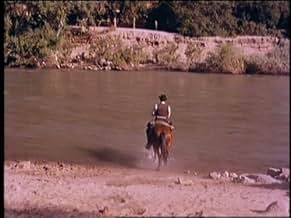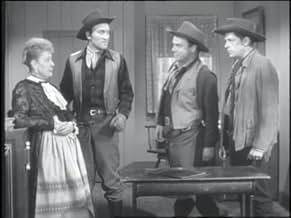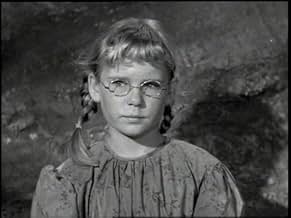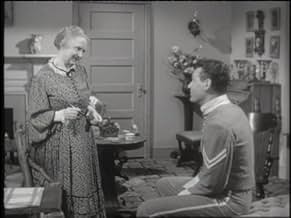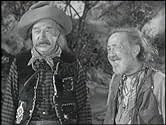Aggiungi una trama nella tua linguaThe adventures of the masked Texas Ranger and his Native American partner.The adventures of the masked Texas Ranger and his Native American partner.The adventures of the masked Texas Ranger and his Native American partner.
- Candidato a 2 Primetime Emmy
- 3 candidature totali
Recensioni in evidenza
As an adult and watching the earliest episodes, it occurred to me that Tonto, actually gave all the idea's for his partners image. It was Tonto that suggested the mask. It was Tonto that suggested the silver bullets, and it was Tonto that came up with the name for Silver..when he proclaimed that the horse the Lone Ranger saved from death was "Silver White"! At last, as Tonto stood with the lone surviving Ranger over the graves of the others, Tonto, proclaimed "You are all alone now..You Lone Ranger! Of course, the response was "Yes Tonto, I am..The Lone Ranger!
The bonds of friendship and trust for the Lone Ranger and Tonto, was used 25 years later as an example of true friendship in an episode of Happy Days. In this particular episode, where Ritchie wanted to expose Fonzie for hating liver. The remark from Fonzie that typified what a true friendship should be was this "Many people tried to remove the mask of the Lone Ranger, but Tonto "never tried". All of America knew and felt that the truest of friendships would be to be like The Lone Ranger and Tonto.
Clayton Moore and Jay Silverheels are beloved for more than just being actors in a great western that will live forever. They are symbolic of so much more and as I said..will always be my hero's.
And in this there is no disgrace. The Radio Series and the Television Series, along with some Movie Serials, Feature Films, Syndicated Newspaper Comic Strip and Comic Books, all did their part to make "the Masked Man of the Plains and his Faithful Indian companion, Tonto" a deeply seeded element of our collective psyche and of our literary folklore.
As with most legends, it all started gradually, first with a series of Radio Plays, written for local use in Detroit over Radio Station WXYZ. The Creator was one George W. Trendle and the Principal Writer on the Series was Mr. Trendle's brother-in-law, Mr. Fran Striker. The year was 1933 when the Ranger first rode out to " the Plains of the Early Western United States!" The Lone Ranger, Tonto and the Radio Series all successfully guided Depression Era Americans through the mid and late '30's up to and through World War II. But the Post-War Era found the country in the midst of a Super-Nova Explosion of invention and technology. There had been a new communications medium standing ready in the wings, but unable to go forth until both VE Day and VJ Day had been achieved. Once these were accomplished and the World and America was ready to settle down to both Peace and Prosperity. The "New Technology" was, of course was TELEVISION! And we would surely need something else than "Roller Derby" and "Wrestling From Marigold Arena" to fill up the broadcast hours. And while at first, the time that a TV Station had anything on, except that portrait of that Mohican Chief (Test Pattern, Schultz!) Very soon and with post haste, the Networks began tapping their existing Natural Resources, their existing programming! Virtually all would be ripe for adaptation to the TV Screen.
So, the folks over at Lone Ranger, Incorporated were very interested when Producers Jack Chertok, Harry Poppe, Sherman Harris and Jack Wrather all approached them with a deal to put The Masked Man and Tonto on the Television waves, as well as the Radio.
Immediately they went to work and gave us the first season, which made use of the considerable back log of Radio Dramas, all potentially adaptable to TV dramas. They cast Clayton Moore, a fine supporting actor in many a feature film, and with about a dozen years experience. He also had done some work in Serials over at Republic Pictures' "Thrill Factory", which would be invaluable experience in doing "THE LONE RANGER". Cast as his "faithful Indian companion" and partner in bringing Justice to various parts of the Frontier, we had sheer perfection in character-supporting Actor, Jay Silverheels.** We must mention that there was that rift in about '53, when Clayton Moore walked and was replaced with John Hart. After a season or so, Mr. Moore was back in-having been missed so much! Now, Back to Our Story!! The first years of filming gave the episodes a look and a sound all of their own. They made good use of off screen Narrator, which gave these shows a feel of authenticity and an individual, stand-out one of a kind series. The actors employed were all veterans of the movies of the late silent era thru the 1930's and 1940's. A lot of them had been just about exclusively "Cowboy Movie" players. A good example of these is the casting of Glenn Strange (Bartender Sam on "GUNSMOKE") as the vicious, murderous Gang Leader, Butch Cavandish. And it was the Cavendish Gang's massacre of the Texas Rangers that led to the origin of John Reid (thought to have been slain with the other Texas Rangers) as the "LONE RANGER".
In addition to the old timers in the cast, you will find a lot of new and up and coming talent (then) in the cast. We see people like Phyllis Coates, Dwayne Hickman, Denver Pyle and others in the cast from week to week. All of this, along with an always calling for fair-play, justice and peace in a western world.
The last couple of seasons brought some big changes. First was the use of Colour Filming. That made no difference as a Colour TV Set was still a long way off for our household. The second was a new set of musical themes and queues. (Other than Rossini's Finale from "U NO Wutt!") The new music was never a big deal to us, as we preferred the "old Radio" stock stuff.
With this series and two Feature Films done during this period, THE LONE RANGER (Warner Brothers, 1956) and THE LONE RANGER AND THE LOST CITY OF GOLD (United Artists, 1958), the character has been permanently and indelibly impressed in our identity as a People, we Americans!
Also note that some of the first episodes are very short - in some cases only 11 or 12 minutes long. That is because sometimes the sponsor would put two short serials in the same half hour slot. The time really belonged to the sponsor back in those days, and thus early TV schedules looked a lot like radio at first.
One of my favorite episodes was "The Silent Voice" towards the end of season two. The witness to a crime is a stroke victim who is completely paralyzed. The Lone Ranger comes up with a way for the woman to communicate by blinking in response to letters of the alphabet.
The other episode from this early part of the series that sticks out is one in which the wife in a husband/wife crime team betrays the husband and shoots him. He is presumed dead and taken to the undertaker's. The Lone Ranger discovers that the husband is not dead, and the husband makes a confession as to what is going on before he dies as he lies on a slab about to buried - alive. The Lone Ranger tricks the wife by claiming that her husband is still alive. That's what I liked about the Lone Ranger - it really could be very dark. There would always be the happy ending with the criminals rounded up and jailed, but that didn't mean that some good people didn't fall along the way or that something really creepy or cringe-worthy wasn't part of the plot.
Highly recommended if you ever get the chance.
Lo sapevi?
- QuizThe Lone Ranger's young nephew, Dan Reid, who appeared occasionally on this show, was the father of Britt Reid, The Green Hornet. Both characters were created for radio by George W. Trendle.
- BlooperIn the series opening used in syndication, the Lone Ranger is seen riding past rows of trees planted as wind breaks. This practice did not come into use until after the "dust bowl" windstorms of the 1930s.
- Citazioni
[first lines for each episode]
Narrator: The Lone Ranger!
[gunshots are fired]
The Lone Ranger: Hi-yo, Silver!
Narrator: A fiery horse with the speed of light, a cloud of dust and a hearty "Hi-yo Silver" - the Lone Ranger!
The Lone Ranger: Hi-yo, Silver, away!
Narrator: With his faithful Indian companion, Tonto, the daring and resourceful masked rider of the plains led the fight for law and order in the early West. Return with us now to those thrilling days of yesteryear. The Lone Ranger rides again!
- Versioni alternativeThe first three episodes are available edited together as a ersatz feature "Enter the Lone Ranger" (1949) running 68 minutes minus titles and recaps.
- ConnessioniEdited into The Legend of the Lone Ranger (1952)
- Colonne sonoreWilliam Tell Overture: Finale
(uncredited)
Written by Gioachino Rossini
[Played at program opening and during closing credits]
I più visti
- How many seasons does The Lone Ranger have?Powered by Alexa
Dettagli
- Tempo di esecuzione30 minuti
- Proporzioni
- 1.33 : 1
Contribuisci a questa pagina




